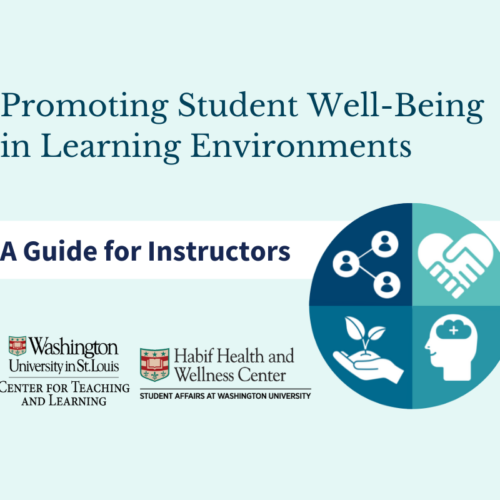Incorporating Student Voices into Lectures: Teaching Tips
 By Tim Bono, Ph.D., Assistant Dean in the College of Arts & Sciences, Lecturer in Psychological & Brain Sciences, Washington University in St. Louis
By Tim Bono, Ph.D., Assistant Dean in the College of Arts & Sciences, Lecturer in Psychological & Brain Sciences, Washington University in St. Louis
One of the most effective techniques I have found to increase student engagement during class is through weekly thought papers.
These low-stakes assignments—simply asking the students to tell a story from their own lives that relates to a topic we have covered—yield responses that are often funny, sometimes poignant, and virtually always valuable for bringing course content to life when incorporated into lecture.
I have found they enhance student learning in the following ways:
1.) They strengthen student memory of the material
When a learner relates a new concept to some aspect of the self—a phenomenon well-documented by memory researchers as “the self-reference effect,”—they process it more deeply and encode it more efficiently, allowing them to retrieve it more easily in the future.
2.) They highlight points of confusion
It’s not uncommon for a student to write a thought paper they think is illustrating a given topic, only to find they have confused that topic with a different one we covered. I can then begin a subsequent class period clarifying the nuances between those theories or ideas.
3.) They pique student interest during class
Cognitive scientists have studied adult attention spans and—newsflash!—no one’s lasts a full 50 minutes in one sitting. For any students who may be lost in reverie in the middle of lecture, when I pause to say, “Now I’d like to read my favorite thought paper from the past week,” I can feel the collective attention of the class being drawn to the front of the auditorium in anticipation of what I’m about to share.
4.) They allow me to personalize lectures
Thought papers teach me a lot about who my students are outside of the classroom, allowing me to bring in examples relevant to their extra-curricular activities or professional aspirations. Such examples also help the students relate the course content to themselves (see #1).
Be it a seminar of twelve students or a large class of more than 300, thought papers have become one of my favorite teaching techniques. They carry benefits for student learning and allow lectures to become more relatable. Best of all, they allow me to get to know my students better, and to tailor my teaching according to their personalities and interests.
——————————–
Of course, you don’t have to take my word for it! Here are some direct student quotes from my course evaluation last semester in response to the item, “Describe at least one thing about this course that helped you learn.”:
- “The thought papers! They were actually fun to write out, and they also let you really connect with the material in the course.”
- “When Dr. Bono would read a student’s thought paper in class, it was a welcome deviation from just straight up lecturing, which kept me engaged and more interested in the material and its application to the real world.”
- “The weekly thought papers forced me to think more in–depth about the topics we were covering in class and how they applied to my life.”
Teaching Tips is a new series of small ideas for making big changes to your teaching. Watch out for more teaching tips throughout the semester on our blog, or head to the Teaching Center’s resource page for more ideas.





